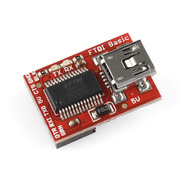| Arduino Ethernet R3 w/o PoE. Credit: Arduino. |
The Arduino Ethernet board combines the Arduino Uno and Arduino Ethernet Shield into a single board. It features the same 14 digital I/O and 6 analog input pins, but similar to the stack configuration, the Ethernet interface takes over pins 10, 11, 12 and 13.
The only significant difference when using this board for the Environment DAQ, is the missing USB-serial driver - it was removed to make room for the Ethernet interface. So how do you upload sketches and output to serial? Well, you'll need to use an FTDI breakout board or FTDI-USB cable. For this example, we'll use Sparkfun's FTDI Basic Breakout - 5V board.
 |
| Sparkfun's FTDI Basic Breakout - 5V. Credit: Sparkfun. |
 |
| Arduino Ethernet with FTDI Breakout. |
Orient the breakout board as seen above such that the "BLK" pin on the Arduino Ethernet lines up with the pin labelled "GND BLK" on the breakout board. From there, you use a mini-USB cable to connect from the FTDI breakout board your computer.
When uploading the sketch, you need to select the Arduino Ethernet board from the list of available boards. On Ubuntu, we found the the Serial port changed from our usual ttyACM- to ttyUSB-.
There isn't anything you need to do for the sketch or shield, they work exactly the same as before, however, we noticed the time it takes to initialize the shield was much longer than on the original stack (operational performance was unchanged).
No comments:
Post a Comment